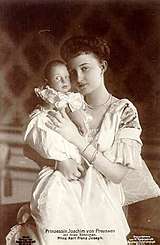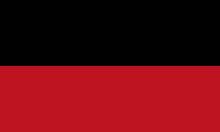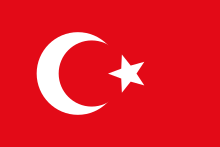Prince Joachim of Prussia
Prince Joachim Franz Humbert of Prussia (17 December 1890 – 18 July 1920) was the youngest son and sixth child of Wilhelm II, German Emperor, by his first wife, Augusta Victoria of Schleswig-Holstein. He died by suicide at age 29.
| Prince Joachim | |
|---|---|
 | |
| Born | 17 December 1890 Potsdam, Kingdom of Prussia, German Empire |
| Died | 18 July 1920 (aged 29) Potsdam, Free State of Prussia, Weimar Republic |
| Burial | 21 July 1920 |
| Spouse | Princess Marie-Auguste of Anhalt |
| Issue | Prince Karl Franz of Prussia |
| House | Hohenzollern |
| Father | Wilhelm II, German Emperor |
| Mother | Princess Augusta Victoria of Schleswig-Holstein |
Candidate for thrones
Ireland
During the Easter Rising in Dublin in 1916, some republican leaders, including Patrick Pearse and Joseph Plunkett, contemplated giving the throne of an independent Ireland to Prince Joachim.[1][2]
Pearse and Plunkett thought that if the rising were successful and Germany won the First World War, an independent Ireland would be a monarchy with a German prince as king, like Romania and Bulgaria before it.[3]
The fact that Joachim did not speak English was also considered an advantage, as he might be more disposed to learning and promoting the use of the Irish language.[4]
In his memoirs, Desmond FitzGerald wrote:
"That would have certain advantages for us. It would mean that a movement for de-anglicisation would flow from the head of the state downwards, for what was English would be foreign to the head of the state. He would naturally turn to those who were more Irish and Gaelic, as to his friends, for the non-nationalist element in our country had shown themselves to be so bitterly anti-German.......For the first generation or so it would be an advantage, in view of our natural weakness, to have a ruler who linked us with a dominant European power, and thereafter, when we were better prepared to stand alone, or when it might be undesirable that our ruler should turn by personal choice to one power rather than be guided by what was most natural and beneficial for our country, the ruler of that time would have become completely Irish."[5]
Ernest Blythe recalls that in January 1915 he heard Plunkett and Thomas MacDonagh express support for the idea at an Irish Volunteers meeting.[6] Bulmer Hobson, secretary of the Volunteers, was among the attendees.[7] No objections were made by anyone and Blythe himself said he found the idea "immensely attractive".[8]
Georgia
After Georgia's declaration of independence following the Russian Revolution of 1917, Joachim was briefly considered by the German representative Count Friedrich Werner von der Schulenburg and Georgian royalists as a candidate to the Georgian throne.[9]
Marriage

Prince Joachim married Princess Marie-Auguste of Anhalt (10 June 1898 – 22 May 1983), the daughter of Eduard, Duke of Anhalt and his wife Princess Luise of Saxe-Altenburg (daughter of Prince Moritz of Saxe-Altenburg), on 11 March 1916.[10] The couple had one son, the Prince Karl Franz Josef Wilhelm Friedrich Eduard Paul (Potsdam, 15 December 1916 – Arica, Chile 22 Jan 1975).
Later life
After his father's abdication, Joachim was unable to accept his new status as a commoner and fell into a deep depression, finally taking his own life by gunshot on 18 July 1920 in Potsdam. One source reports that he had been in financial straits and suffered from "great mental depression".[11] His own brother Prince Eitel Friedrich of Prussia commented that he suffered from "a fit of excessive dementia".[11] Before his death, the couple had recently divorced. The direct causes are not really known to the public, only that there had been no previous report of marital troubles before the divorce was announced.[12] Regardless of the reasons, this event may have also contributed to his depression.
Children and grandchildren
The only issue of the marriage of Prince Joachim and Princess Marie-Auguste was their son, Prince Karl Franz Josef Wilhelm Friedrich Eduard of Prussia (15 December 1916 – 22 January 1975).
On 5 October 1940, Prince Karl married Princess Henriette Hermine Wanda Ida Luise von Schönaich-Carolath (25 November 1918 – 16 March 1972). They divorced on 5 September 1946. They were the parents of three children:
- Prince Franz Wilhelm Viktor Christoph Stephan of Prussia (born 3 September 1943), he married Maria Vladimirovna, Grand Duchess of Russia, a claimant to the disputed Russian throne. Their child is Grand Duke George Mikhailovich of Russia, Prince of Prussia, born 13 March 1981 in Spain.
- Prince Friedrich Christian Ludwig of Prussia (3 September 1943 – 26 September 1943)
- Prince Franz Friedrich Christian of Prussia (born 17 October 1944).
After the divorce, Prince Karl married, morganatically, Luise Dora Hartmann (5 September 1909 – 23 April 1961) on 9 November 1946. The childless couple divorced in 1959.
Prince Karl's last marriage was to Eva Maria Herrera y Valdeavellano (10 June 1922 – 6 March 1987) on 20 July 1959 in Lima, Peru. They were married until Prince Karl's death and had two daughters;
- Alexandra Maria Augusta Juana Consuelo Prinzessin von Preussen (born 29 April 1960)
- Désirée Anastasia Maria Benedicta Prinzessin von Preussen (born 13 July 1961).
Regimental Commissions
- Leutnant (2nd Lieutenant), 1. Garderegiment zu Fuß (1st Regiment of Foot Guards)[13]
- à la suite, 4. Gardegrenadierlandwehrregiment (4th Reserve Regiment of Grenadier Guards)
Orders and decorations
- German[13]
.svg.png)
- Knight of the Black Eagle, with Collar
- Grand Cross of the Red Eagle, with Crown
- Knight of the Prussian Crown, 1st Class
- Grand Commander of the Royal House Order of Hohenzollern
- Iron Cross, 2nd and 1st Classes


- Grand Cross of Albert the Bear
- Friedrich Cross
.svg.png)
.svg.png)




- Grand Cross of the Wendish Crown, with Golden Crown
- Military Merit Cross, 1st Class (Schwerin)



.svg.png)
.svg.png)
- Knight of the Rue Crown
- Knight of the Albert Order, 1st Class with Crown and Swords

- Foreign[15]
.svg.png)



Ancestry
| Ancestors of Prince Joachim of Prussia | |||||||||||||||||||||||||||||||||||||||||||||||||||||||||||||||||||||||||||||||||||||||||||||||||||||||||||||||||||||||||||||||||||||||||||||||||||||||||||||||||||||||||||||||||||||||||||||||||||||||||||||||||||||||||||||||||||||||||||||||||||||||||||||||||||||||||||||||||||||||||
|---|---|---|---|---|---|---|---|---|---|---|---|---|---|---|---|---|---|---|---|---|---|---|---|---|---|---|---|---|---|---|---|---|---|---|---|---|---|---|---|---|---|---|---|---|---|---|---|---|---|---|---|---|---|---|---|---|---|---|---|---|---|---|---|---|---|---|---|---|---|---|---|---|---|---|---|---|---|---|---|---|---|---|---|---|---|---|---|---|---|---|---|---|---|---|---|---|---|---|---|---|---|---|---|---|---|---|---|---|---|---|---|---|---|---|---|---|---|---|---|---|---|---|---|---|---|---|---|---|---|---|---|---|---|---|---|---|---|---|---|---|---|---|---|---|---|---|---|---|---|---|---|---|---|---|---|---|---|---|---|---|---|---|---|---|---|---|---|---|---|---|---|---|---|---|---|---|---|---|---|---|---|---|---|---|---|---|---|---|---|---|---|---|---|---|---|---|---|---|---|---|---|---|---|---|---|---|---|---|---|---|---|---|---|---|---|---|---|---|---|---|---|---|---|---|---|---|---|---|---|---|---|---|---|---|---|---|---|---|---|---|---|---|---|---|---|---|---|---|---|---|---|---|---|---|---|---|---|---|---|---|---|---|---|---|---|---|---|---|---|---|---|---|---|---|---|---|---|---|---|---|---|
| |||||||||||||||||||||||||||||||||||||||||||||||||||||||||||||||||||||||||||||||||||||||||||||||||||||||||||||||||||||||||||||||||||||||||||||||||||||||||||||||||||||||||||||||||||||||||||||||||||||||||||||||||||||||||||||||||||||||||||||||||||||||||||||||||||||||||||||||||||||||||
References
| Wikimedia Commons has media related to Prince Joachim of Prussia. |
- Memoirs of Desmond FitzGerald, 1913-1916, Desmond FitzGerald; Routledge & K. Paul, 1968, page 141
- Irish nationalism: a history of its roots and ideology, Seán Cronin, Continuum, 1981, page 255
- The Irish Factor, 1899-1919: Ireland's Strategic and Diplomatic Importance for Foreign Powers, Jérôme aan De Wiel, Irish Academic Press, 2008, page 66
- Abject Loyalty: Nationalism and Monarchy in Ireland During the Reign of Queen Victoria, James H. Murphy, CUA Press, 2001, page 301
- Inside the GPO in 1916: Desmond FitzGerald’s eyewitness account, Irish Times, March 21, 2016
- Irish nationalism: a History of Its Roots and Ideology, Seán Cronin, Continuum, 1981, page 255
- Republicanism in Ireland: Confronting Theories and Traditions, Iseult Honohan, Manchester University Press, 2008, page 165
- An Irish Monarchy, The Irish Times, 15 April 1966
- (in French)Le Caucase dans les plans stratégiques de l'Allemagne (1941-1945) Centre d'études d'histoire de la defense, 29, Georges Mamoulia, 2006, page 53
- "Prince Joachim Married", The New York Times, Amsterdam, 12 March 1916
- "Kaiser's Youngest Son, Joachim Shoots Himself", The New York Times, Berlin, 18 July 1920
- "Two of ex-Kaiser's Sons Bring Suits For Divorce", The New York Times, Paris, 8 January 1920
- Handbuch über den Königlich Preußischen Hof und Staat (1918), Genealogy pp. 2-3
- Hof- und Staats-Handbuch des Großherzogtum Baden (1910), "Großherzogliche Orden" p. 41
- Handbuch über den Königlich Preussischen Hof und Staat, 1908, p. 2
- "A Szent István Rend tagjai" Archived 22 December 2010 at the Wayback Machine
- The London Gazette, issue 27704, p. 5191